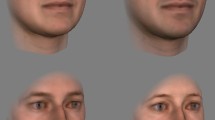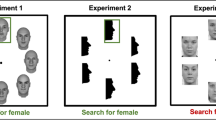Abstract
People can reliably distinguish the sex of faces across age groups. Rates of accuracy are lower for infants, however, likely because they lack the pronounced sexually dimorphic features that develop during puberty. Given that previous research has shown that perceivers categorize adult sex automatically, we wondered whether this would extend to the faces of infants for whom sex is less legible. We tested this using a semantic priming paradigm in which infant faces preceded the categorization of stereotypically male and female names. Results showed that participants categorized the sex of male names significantly faster following perceptions of male versus female infant faces (though female faces did not significantly facilitate the processing of female names). The asymmetry in interference for male but not female faces supports evidence for a male default in conceptions of sex among infants previously found for adults. Individuals may therefore process sex automatically in the absence of overt cues (e.g., post-pubertal sexually dimorphic features or stereotypical clothing), providing additional evidence for the depth and flexibility of social categorization.

Similar content being viewed by others
Notes
Participants did not report spending much time with children: Mdn = 1 hours/week, SD = 10.35. All results remained consistent when we removed the five outlier participants from the sample.
The photographs of two male and one female infant had to be excluded from analysis due to a programming error that caused the pictures to not load during the experiment. We excluded a picture of another female infant from the database due to low image quality.
Pilot testing of the images indeed revealed that the participants categorized the infants’ faces more accurately than chance, though less accurately than the rates usually found for adult faces (e.g., Cheng et al. 2001), M A′ = .70, SD = .10, t(22) = 10.35, p < .001, r = .90.
References
Ambady, N., & Rosenthal, R. (1992). Thin slices of expressive behavior as predictors of interpersonal consequences: A meta-analysis. Psychological Bulletin, 111, 256–274.
Antoszewska, A., & Wolański, N. (1991). Sexual dimorphism in newborns and adults. Studies in Human Ecology, 10, 23–38.
Brewer, M. B. (1988). A dual-process model of impression formation. In R. S. Wyer Jr & T. K. Srull (Eds.), Advances in social cognition (Vol. 1, pp. 1–36). Mahwah, NJ: Erlbaum.
Brown, E., & Perrett, D. I. (1993). What gives a face its gender? Perception, 22, 829–840.
Chen, M., & Bargh, J. A. (1999). Consequences of automatic evaluation: Immediate behavioral dispositions to approach or avoid the stimulus. Personality and Social Psychology Bulletin, 25, 215–224.
Cheng, Y. D., O’Toole, A. J., & Abdi, H. (2001). Classifying adults’ and children’s faces by sex: Computational investigations of subcategorical feature encoding. Cognitive Science, 25, 819–838.
Cloutier, J., Freeman, J. B., & Ambady, N. (2014). Investigating the early stages of person perception: The asymmetry of social categorization by sex vs. age. PLoS ONE, 9, e84677.
Crosby, F., & Nyquist, L. (1977). The female register: An empirical study of Lakoff’s hypothesis. Language in Society, 6, 313–322.
Fiske, S. T., & Neuberg, S. L. (1990). A continuum of impression formation, from category-based to individuating processes: Influences of information and motivation on attention and interpretation. Advances in Experimental Social Psychology, 23, 1–74.
Freeman, J. B., & Ambady, N. (2011). A dynamic interactive theory of person construal. Psychological Review, 118, 247–279.
Johnson, K. L., & Tassinary, L. G. (2005). Perceiving sex directly and indirectly: Meaning in motion and morphology. Psychological Science, 16, 890–897.
Kaminski, G., Meary, D., Mermillod, M., & Gentaz, E. (2011). Is it a he or a she? Behavioral and computational approaches to sex categorization. Attention, Perception, & Psychophysics, 73, 1344–1349.
Kozlowski, L. T., & Cutting, J. E. (1977). Recognizing the sex of the walker from a dynamic point-light display. Perception and Psychophysics, 21, 575–580.
Macrae, C. N., Alnwick, K. A., Milne, A. B., & Schloerscheidt, A. M. (2002). Person perception across the menstrual cycle: Hormonal influences on social-cognitive functioning. Psychological Science, 13, 532–536.
Macrae, C. N., & Bodenhausen, G. V. (2000). Social cognition: Thinking categorically about others. Annual Review of Psychology, 51, 93–120.
Macrae, C. N., & Martin, D. (2007). A boy primed Sue: Feature-base processing and person construal. European Journal of Social Psychology, 37, 793–805.
Macrae, C. N., & Quadflieg, S. (2010). Perceiving people. In S. Fiske, D. T. Gilbert, & G. Lindzey (Eds.), The handbook of social psychology (5th ed., pp. 428–463). New York, NY: McGraw-Hill.
O’Toole, A. J., Vetter, T., Troje, N. F., & Bulthoff, H. H. (1997). Sex classification is better with three-dimensional head structure than with image intensity information. Perception, 26, 75–84.
Poisson, J. (2011, May 21). Parents keep child’s gender secret. Toronto Star. Retrieved from http://www.thestar.com/life/parent/2011/05/21/parents_keep_childs_gender_secret.html.
Porter, R. H., Cernoch, J. M., & Balogh, R. D. (1984). Recognition of neonates by facial-visual characteristics. Pediatrics, 74, 501–504.
Rheingold, H. L., & Cook, K. V. (1975). The contents of boys’ and girls’ rooms as an index of parents’ behavior. Child Development, 46, 459–463.
Round, J. E. C., & Deheragoda, M. (2002). Sex—can you get it right? British Medical Journal, 325, 1446–1447.
Rule, N. O., & Ambady, N. (2008). Brief exposures: Male sexual orientation is accurately perceived at 50 ms. Journal of Experimental Social Psychology, 44, 1100–1105.
Rule, N. O., & Ambady, N. (2010). Democrats and Republicans can be differentiated from their faces. PLoS ONE, 5, e8733.
Rule, N. O., Ambady, N., Adams, R. B, Jr, & Macrae, C. N. (2007). Us and them: Memory advantages in perceptually ambiguous groups. Psychonomic Bulletin & Review, 14, 687–692.
Rule, N. O., Ambady, N., Adams, R. B, Jr, & Macrae, C. N. (2008). Accuracy and awareness in the perception and categorization of male sexual orientation. Journal of Personality and Social Psychology, 95, 1019–1028.
Rule, N. O., Garrett, J. V., & Ambady, N. (2010). On the perception of religious group membership from faces. PLoS ONE, 5, e14241.
Rule, N. O., Krendl, A. C., Ivcevic, Z., & Ambady, N. (2013). Accuracy and consensus in judgments of trustworthiness from faces: Behavioral and neural correlates. Journal of Personality and Social Psychology, 104, 409–426.
Rule, N. O., Macrae, C. N., & Ambady, N. (2009). Ambiguous group membership is extracted automatically from faces. Psychological Science, 20, 441–443.
Samochowiec, J., Wänke, M., & Fiedler, K. (2010). Political ideology at face value. Social Psychological and Personality Science, 1, 206–213.
Smith, E. R., & Zarate, M. A. (1992). Exemplar-based model of social judgment. Psychological Review, 99, 3–21.
Stern, M., & Karraker, K. H. (1989). Sex stereotyping of infants: A review of gender labeling studies. Sex Roles, 20, 501–522.
Thornhill, R., & Gangestad, S. W. (1996). The evolution of human sexuality. Trends in Ecological Evolution, 11, 98–102.
Tskhay, K. O., & Rule, N. O. (2013). Accuracy in categorizing perceptually ambiguous groups: A review and meta-analysis. Personality and Social Psychology Review, 17, 72–86.
Tskhay, K. O., & Rule, N. O. (2015). Semantic information influences race categorization from faces. Personality and Social Psychology Bulletin, 41, 769–778.
Wild, H. A., Barrett, S. E., Spence, M. J., O’Toole, A. J., Cheng, Y. D., & Brooke, J. (2000). Recognition and sex categorization of adults’ and children’s faces: Examining performance in the absence of sex-stereotyped cues. Journal of Experimental Child Psychology, 77, 269–291.
Zaraté, M. A., & Smith, E. R. (1990). Person categorization and stereotyping. Social Cognition, 8, 161–185.
Zebrowitz, L. A. (1997). Reading faces: Window to the soul? Boulder, CO: Westview Press.
Acknowledgments
The authors would like to express thanks to Rebecca Zhu, Daniel Glizer, and Elizabeth Page-Gould for their suggestions during the initial stages of this project. This work was supported in part by a grant from the Social Sciences and Humanities Research Council of Canada to NOR.
Author information
Authors and Affiliations
Corresponding author
Rights and permissions
About this article
Cite this article
Tskhay, K.O., Rule, N.O. People Automatically Extract Infants’ Sex from Faces. J Nonverbal Behav 40, 247–254 (2016). https://doi.org/10.1007/s10919-016-0235-y
Published:
Issue Date:
DOI: https://doi.org/10.1007/s10919-016-0235-y




